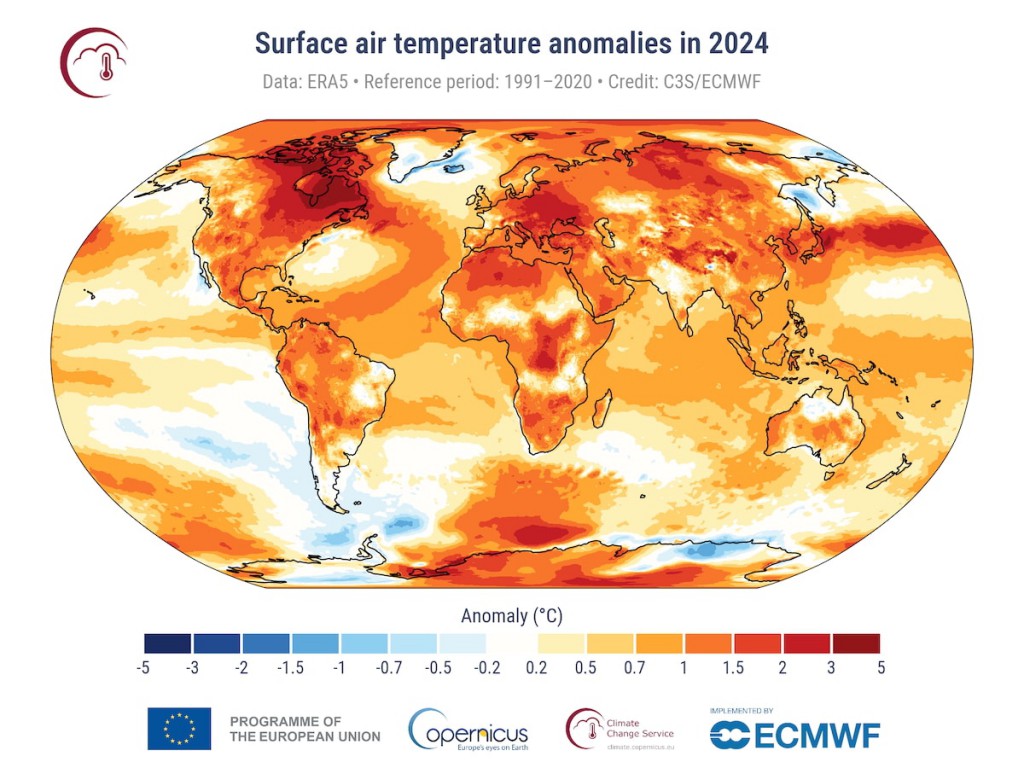Interactive maps and charts reveal growing risks to the planet
The World Meteorological Organization (WMO) has released a new report, “State of the Climate 2024,” which analyzes key climate indicators and documents unprecedented changes on a global scale. The report, presented in an interactive storymap and created with the help of Esri GIS technologies, shows that 2024 was the warmest year on record. The global average temperature was 1.55°C (±0.13°C) above the pre-industrial level (1850-1900). This is further evidence that climate change is accelerating and leading to increasingly serious consequences for ecosystems, economies and the lives of people around the world.

Record Greenhouse Gas Concentrations
Greenhouse gas emissions continue to rise, with concentrations reaching their highest levels in recorded history:
• Carbon dioxide (CO₂): 420.0 ppm (151% of pre-industrial levels);
• Methane (CH₄): 1923 ppb (266% of pre-industrial levels);
• Nitrous oxide (N₂O): 335.8 ppb (124% of pre-industrial levels).
These gases are the main drivers of global warming, and their continued increase shows that the world has not yet succeeded in limiting emissions despite international commitments to combat climate change.
Oceans – unprecedented warming and sea level rise
About 90% of the additional heat accumulated in the climate system is absorbed by the oceans, leading to a steady increase in sea water temperatures. In 2024 It has reached new record levels, with warming set to become irreversible within the next few centuries. Rising ocean temperatures are causing massive coral bleaching and contributing to more intense hurricanes and cyclones in coastal regions.
What’s happening to the glaciers?
The melting of glaciers and sea ice continues at an accelerated pace. Arctic sea ice has reached its seventh lowest minimum extent in satellite records, and Antarctic sea ice has reached its second lowest minimum extent. This is contributing to sea level rise, which has reached a record high, with the rate of rise doubling: from 2.1 mm/year (1993-2002) to 4.7 mm/year (2015-2024). Although these values may seem insignificant at first glance, even a few millimeters per year increase the risk of coastal flooding and erosion, threatening megacities such as New York, London, Mumbai and Tokyo, WMO experts report.
Melting glaciers not only raise sea levels, but also impede the water supply of hundreds of millions of people who rely on mountain glaciers for fresh water.
Extreme weather events
2024 is marked by a number of extreme weather events, such as record heat waves in Europe, North America and Asia, which led to thousands of deaths and significant economic losses. Serious floods in South America and Africa affect millions of people. Prolonged droughts are causing food security crises in several regions, particularly in Africa and the Middle East.
How was the report produced?
The State of the Climate 2024 report is based on internationally recognized climate datasets, including those from NASA, NOAA, the UK Met Office and the European Centre for Medium-Range Weather Forecasts (ECMWF). It uses satellite observations, ground stations and climate models to provide detailed global trends.
The WMO annual report is presented in an interactive format through ArcGIS StoryMaps, using Esri Geographic Information Systems (GIS). Through dynamic maps and animations, users can explore:
• Global temperature anomalies and how they have changed over recent decades;
• Droughts and heavy rainfall around the world;
• Sea level changes;
• Ocean heat content and its effects on marine ecosystems;
• Glaciers and snow cover – how they change over time;
• The frequency of extreme weather events and their relationship to global warming.
The full report and interactive visualizations are available on the WMO storymap.
###